Last Updated: November 30, 2025
It seems every “cool” startup is hiring forward deployed engineers (FDE) these days. But what exactly are these mythical creatures? How much has demand grown? And more importantly, how much are they getting paid?
While Palantir was the one who coined the original title ‘forward deployed engineer’, they unfortunately don’t get to decide what a FDE really is. Neither do thought leaders, venture capital bros, or LinkedIn influencers (sorry, I don’t make the rules).
So, I decided to analyze 1,000 forward deployed engineer job postings (provided by Revealera, a jobs data provider to financial firms) to see how other companies are describing this job…
- Intro: How are most companies defining “forward deployed engineer”
- Top 10 Responsibilities of a forward deployed engineer
- Demand for FDE Engineers has grown 1165% in 2025
- Average salary for FDE Engineers
- Average years of experience required for FDE Engineers
- What coding skills do FDE Engineers need?
- What AI/ML skills do FDE Engineers need?
- What industries do FDE Engineers commonly work with?
- What soft skills do FD Engineers need?
- What kind of companies typically hire FDE Engineers?
- Are forward deployed engineers just sales engineers?
- Are forward deployed engineers just solution engineers?
Intro: How are most companies defining ‘forward deployed engineer’
Here’s the problem: if you search “forward deployed engineer” jobs, you’ll find job postings that seem to describe completely different roles. Some emphasize heavy coding and travel. Others focus on demos and sales support. Some are building AI agents, others are configuring CRM integrations.
So what’s actually going on?
After analyzing all these FDE job postings, here’s what I learned: companies use “Forward Deployed Engineer” to describe three different jobs.
No wonder people are confused, and asking what the heck is a forward deployed engineer!
Type 1: The Builder FDE (60% of jobs – the majority)
This is what most people think of when they hear “Forward Deployed Engineer.”
You’re a software engineer who embeds directly with customers to build, deploy, and maintain complex technical systems in production. Think of it as the hybrid of a senior software engineer and a technical consultant, but with way more code and way less PowerPoint.
Some specific examples from job postings:
Reducto: “Work within customer systems to build production applications with Claude models” and “deliver technical artifacts for customers like MCP servers, sub-agents, and agent skills that will be used in production workflows.”
Intercom: “Work hands-on with customers’ technical teams as a technical expert and trusted advisor, coding side-by-side to drive projects to completion.”
ConductorOne: “Design and implement connectors using Baton to legacy HR systems” and “build custom dashboards and reporting solutions for executive stakeholders.”
Databricks: “Embed with strategic customers to architect, design, and deploy AI/ML-powered solutions tailored to customer needs” and “design and develop applications spanning backend, frontend, and integrations.”
Vanta: “Embed with customer teams to design and implement integrations, data transformations, and reporting workflows” and “work hands-on across the stack — from APIs and SDKs to infrastructure configuration.”
Anyscale: “Embedded within customer teams” to “lead proof-of-value engagements, deployments, and enterprise adoption” while “spending extended time embedded with customers.”
Since the majority of companies are defining forward deployed engineers this way, this is the definition we’re going to stick with.
Key markers: 70-90% coding, 30-50% travel, $140-250K salary, high equity
Type 2: The Sales Engineer+ (30% of jobs)
This is a solutions engineer or sales engineer role that got rebranded as “FDE.”
They support sales cycles with technical demos and POCs, lead customer implementations, and configure the product to fit customer needs. They write some code, but most of their time is spent in customer meetings, training sessions, and internal collaboration with sales.
The key difference: They hand off to implementation teams rather than building everything themselves.
Key markers: 30-40% coding, <20% travel, $120-200K + commission, quota-carrying
Type 3: The Internal Tools Builder (10% of jobs)
This is a GTM engineer or RevOps role that definitely shouldn’t be called “forward deployed engineer” at all.
They build automation and tools for your company’s internal Sales, Marketing, and Customer Success teams, using tools like Clay. Their “customers” are internal stakeholders, not external clients. A needed role in many orgs… just not what most companies are calling a forward deployed engineer.
Key markers: Internal-facing only, CRM integrations, <5% travel, $100-180K
My article focuses on Type 1 – the Builder FDE. That’s the the most popular definition of the forward deployed engineer role that most companies have, based on job postings.
Now let’s dive into what I learned from analyzing 1000+ of these roles.
1. The top 10 responsibilities of a Forward Deployed Engineer
What were the the top 10 most common responsibilities mentioned in forward deployed engineer jobs?
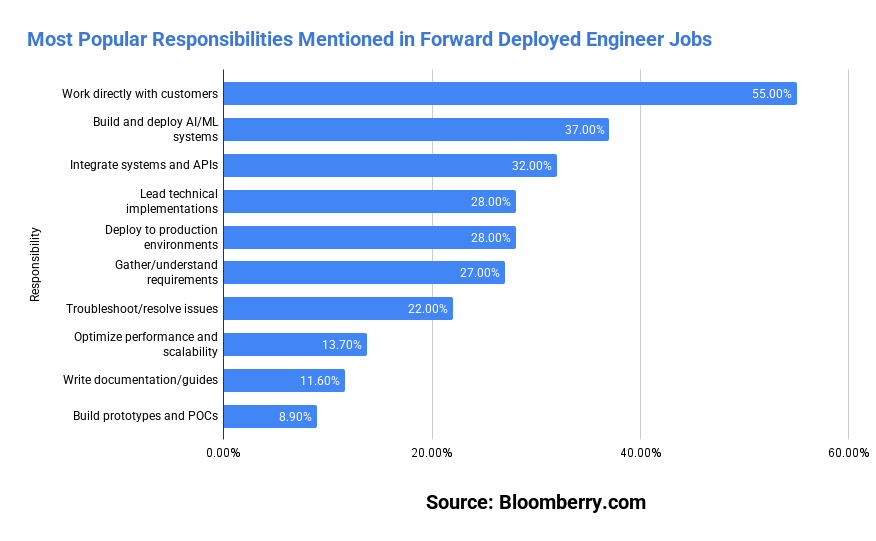
Working directly with customers (55%) is the overwhelming #1 responsibility.
Building and deploying AI/ML systems (37%) and integrating systems/APIs(32%) were #2 and #3.
Forward deployed engineers spend most of their time on production engineering work (building systems, integrating APIs, troubleshooting issues, optimizing performance), not pre-sales activities, or doing demos.
And notice what’s completely absent from this list: “Hit quota.” “Close deals.” “Generate pipeline.” “Achieve sales targets.” Not a single job mentioned revenue responsibility as a core duty. This is because forward deployed engineers is an engineering role, *not* a sales role.
2. Demand for Forward Deployed Engineers is up 1165% in 2025

How has the demand of FDE’s grown year over year?
To find out, I compared the number of job postings with the job title “forward deployed engineer” from January through October 2025 vs the same period in 2024. Forward deployed engineer jobs exploded by 1,165% year-over-year.
And it’s not slowing down either. In the past 3-4 months, the growth has dramatically accelerated. October 2025 had the highest # of job postings for forward deployed engineers ever.
In 2023-2024, most companies were still figuring out how to use ChatGPT for basic tasks. In 2025, they’re now trying to deploy AI agents into production systems.
You can’t just hand that off to a sales engineer who does a nice demo and moves on. You need someone who can actually embed with the customer, write production code, and ensure the AI doesn’t fall apart when it hits real-world complexity.
3. The average FDE salary is $173,816 per year
Forward Deployed Engineer salaries vary, but the median comes in at $173,816 based on jobs that disclosed salary ranges.
70% of FDE jobs mention equity. Only 8% mention OTE (on-target earnings). And exactly 0% are quota-carrying roles.
If this were just a rebranded sales position, you’d see commission structures, OTEs, and quotas everywhere. But you don’t. Forward deployed engineers are compensated like engineers, not salespeople.
Now, here are the top 10 companies paying the most for forward deployed engineers:
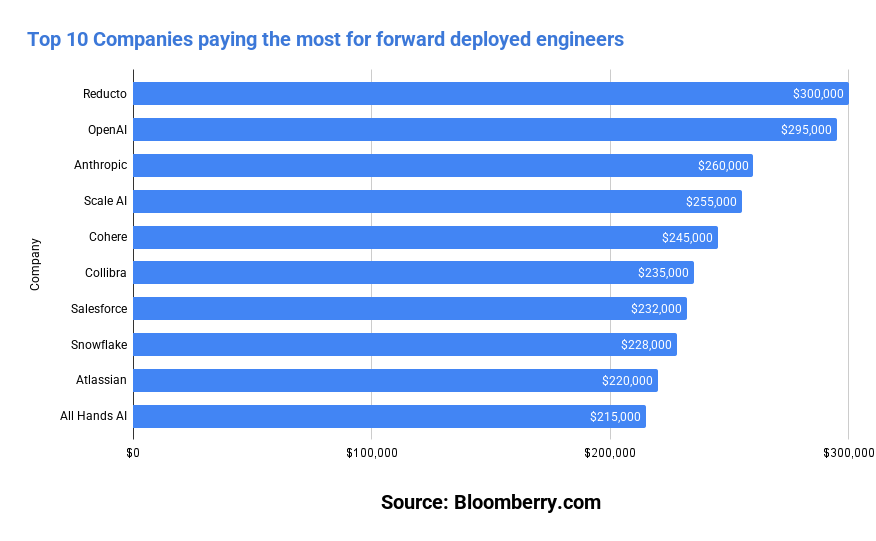
AI/ML platforms, data infrastructure companies, and well-funded startups dominate the top spots. And these numbers are just base salary. Most of these companies also offer equity packages worth 0.1% to 1.5% that can be worth hundreds of thousands of dollars.
3b. The average years of experience expected is 5
There’s a perception that customer-facing roles are somehow less prestigious than “pure” engineering. The data though suggests that most FDE engineering jobs require a fair bit of experience.
The experience breakdown among jobs that specify:
- Entry-level (0-2 years): 12% – Rare, mostly at companies building FDE programs
- Mid-level (3-5 years): 60% – The most popular
- Senior (6-8 years): 20% – Common for complex deployments
- Staff+ (9+ years): 8% – For most strategic accounts
FDEs are typically hired at mid-to-senior levels, not junior levels. Companies want engineers who’ve already proven themselves.
Where do FDEs sit organizationally?
Many job postings give us a clue as what teams they’ll be a part of, and who they’ll report to.
- 45% mention FDE as its own dedicated team – Not reporting into sales or customer success
- 38% position as engineering org – “Part of the product engineering team”
- 14% mention GTM/sales team
- 7% mention customer success teams
- 7% mention solutions/professional services
4. What coding skills do FDE Engineers need?
If you can’t code, you can’t be a Forward Deployed Engineer. Full stop.
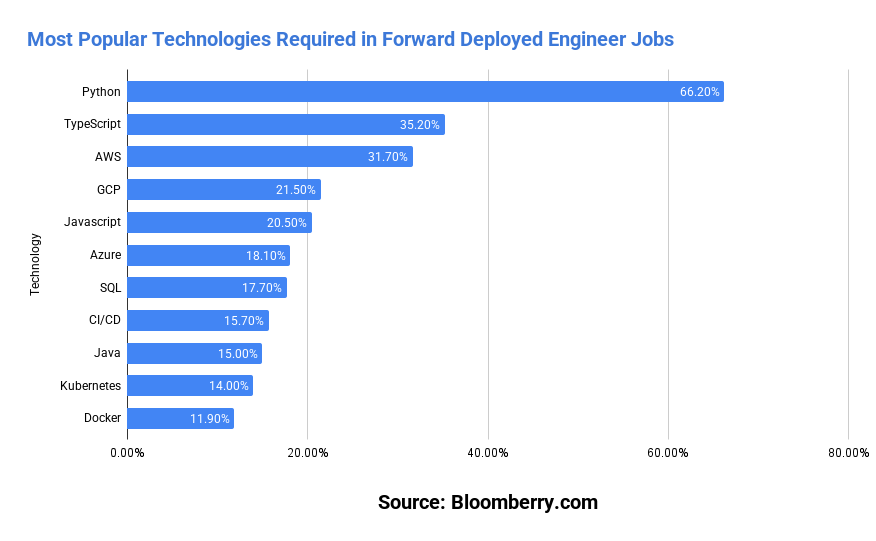
Among the top 10 technologies mentioned in forward deployed engineer jobs, Python dominates at 66% of job postings. That’s not surprising.
But here’s what surprised me a bit: TypeScript shows up in 35% of jobs. That’s higher than I expected and tells us something: forward deployed engineers aren’t just backend infrastructure engineers. They’re building full-stack solutions, often creating custom dashboards for customers.
The rest of the tech stack reads like a typical engineering role:
- AWS (32%), GCP (22%), Azure (18%) – multi-cloud is the norm, not the exception
- Kubernetes (14%), Docker (12%) – container orchestration is expected
The bottom line? If you’re coming from a pure sales background without coding skills, you’re not getting hired as an FDE. You need to write actual production code. Not kiddy scripts. And god forbid, not vibe coding! Real systems that customers depend on.
5. 35% of FDE jobs mention AI agents, 31% require LLM experience
Here’s the breakdown of the most popular AI skills mentioned:
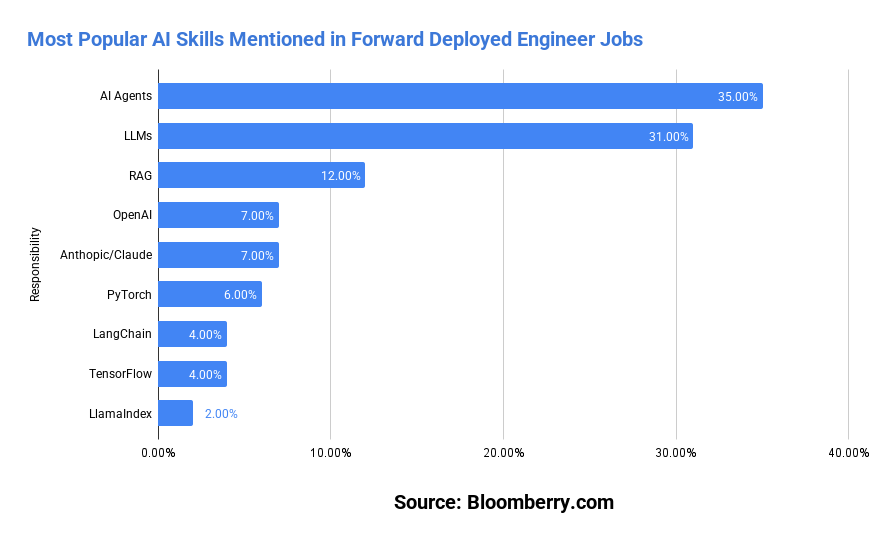
- AI Agents (35%) – building systems that act autonomously
- LLM experience (31%) – working with large language models is now a core skill
- RAG (Retrieval-Augmented Generation) (12%) – this architecture is becoming standard
- OpenAI (8%), Anthropic/Claude (7%) – provider-agnostic is key
- LangChain (4%), LlamaIndex (2%) – orchestration frameworks are emerging
Compare this to traditional ML frameworks:
- PyTorch (6%), TensorFlow (4%) – still relevant but not the focus
What this tells us: FDE roles in 2025 are leaned more on generative AI and agentic systems, not traditional machine learning.
If you want to break into FDE, get comfortable with:
- Building RAG pipelines that don’t hallucinate
- Deploying LLMs that stay within latency budgets
- Creating agentic workflows that fail gracefully
- Making AI systems that enterprises can actually trust
The companies hiring FDEs right now aren’t looking for people who can fine-tune BERT (that’s more for machine learning engineers). They want engineers who can deploy Claude or GPT-4 into mission-critical systems and make sure it actually works.
6. Financial services, government, and healthcare are the top customer industries FDEs deploy into
79% of FDE job postings don’t specify what customer industries you’ll be working with. That tells us most FDEs need to be vertical-agnostic.
But for the 21% of jobs that DO specify target customers, here were the most popular industries of customers that need forward deployed engineers:
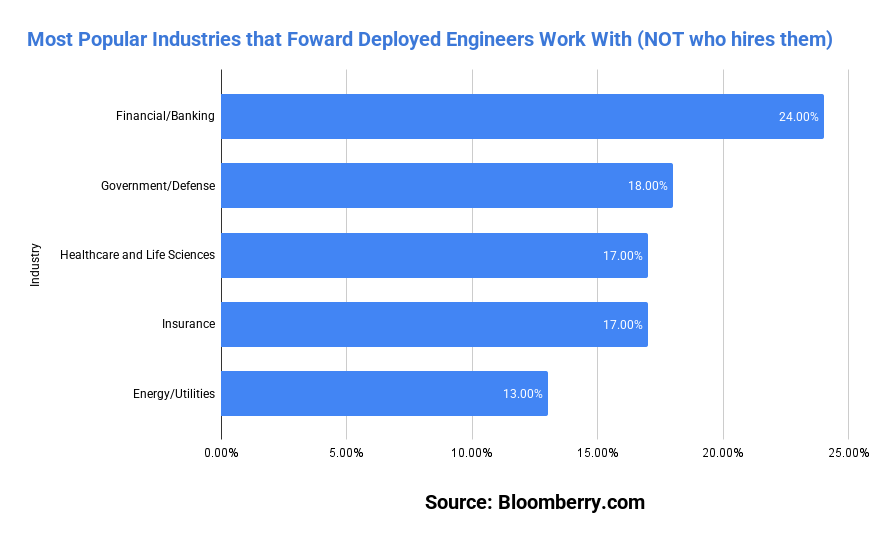
- Financial Services/Banking (24%) – Document processing AI, risk models, trading systems, compliance automation
- Examples: Reducto (financial document AI), Galileo (ML observability for financial models), TaxBit (tax compliance for financial institutions), Droit (regulatory compliance for trading)
- Government/Defense (18%) – Secure AI deployments, air-gapped systems, FedRAMP compliance, classified environments
- Examples: Lockheed Martin (defense AI systems), Scale AI (DoD AI projects), Obviant (defense/intel solutions), Accenture Federal (government consulting)
- Healthcare/Life Sciences (17%) – Clinical documentation, medical coding, drug discovery, HIPAA-compliant systems
- Examples: Anthropic (Claude for healthcare use cases), Commure (hospital software), Foundation Health (healthcare platform), Cohere (healthcare LLM applications)
- Insurance (17%) – Claims automation, underwriting AI, policy document processing
- Examples: Federato (commercial insurance AI), Kalepa (underwriting AI), Nirvana Tech (insurance automation), Acrisure (insurance brokerage tech)
- Energy/Utilities (13%) – Grid management, forecasting models, asset optimization
- Examples: Atlassian (enterprise software for utilities), Accenture (energy practice), various infrastructure platforms
These are all highly regulated, complex industries where AI deployment is hard. They pay a premium because deployment complexity is the entire value proposition.
7. What soft skills are desired for a forward deployed engineer?
We discussed technical skills, but what are the most popular soft skills mentioned in FDE jobs?
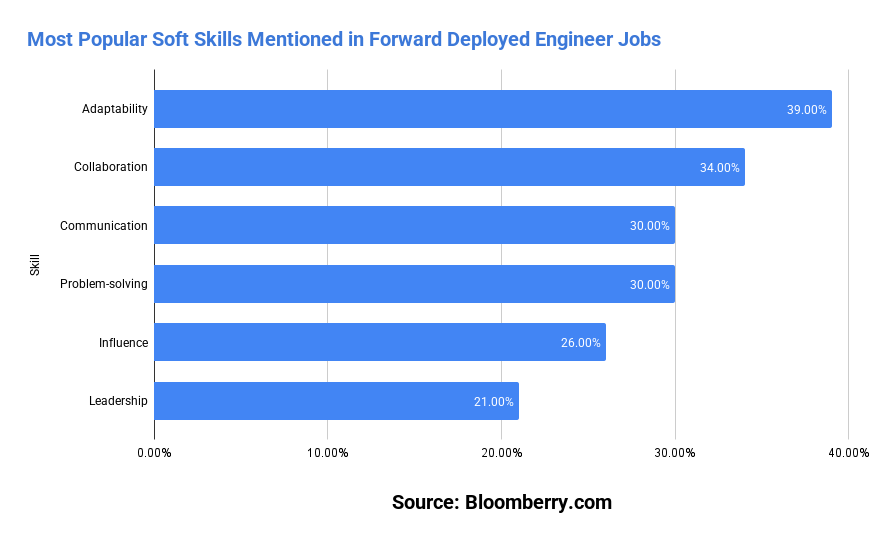
You can be the world’s best AI engineer, but if you can’t sit in a conference room with a non-technical VP and explain why their AI agent keeps failing without making them feel stupid, you won’t succeed as an FDE.
The technical bar is high (hence the $174K average salary). But the differentiator is soft skills. Plenty of engineers can write Python and deploy models. Far fewer can:
- Adapt to a new customer’s industry and tech stack every few months
- Communicate to VPs on why you need to do things a certain way
- Own an entire deployment when things go sideways at 2 AM
- Influence a customer’s engineering team to adopt your architecture recommendations
If you’re a brilliant engineer who hates people, stay in core engineering. If you’re a sales engineer who can’t code, you won’t make it. But if you’re a solid engineer who genuinely enjoys helping customers succeed, and love talking to customers, FDE is your perfect role.
8. Growth-stage startups have the most forward deployed engineer jobs
How big are companies who usually hire forward deployed engineers?

58% of FDE roles are at companies with 11-200 employees. These are growth-stage startups that have some product-market fit and are trying to scale.
Why? Because FDEs are a scaling strategy for complex products.
Early-stage startups (2-10 people) can’t afford FDEs – the founders are doing the deployments themselves.
Large enterprises (1,000+) have dedicated implementation teams, professional services, and partner networks. They don’t need FDEs for every customer.
But growth-stage startups (11-200 employees)? They’re in the awkward middle:
- Product is too complex for self-serve
- Can’t afford a massive services org yet
- Every customer deployment is still somewhat custom
- Need to move fast and learn from customers
- Strategic accounts require white-glove treatment
That’s where FDEs thrive. You’re engineer #15 at an AI startup, embedding with the first 10 customers to figure out what actually works before productizing it.
9. Forward Deployed Engineers and Sales Engineers are NOT the same role
Some companies are clearly rebranding sales engineering jobs as ‘forward deployed engineers’.
But if you read the job descriptions, here’s how you can check the difference between a true FDE and a glorified sales engineer:
| Dimension | Forward Deployed Engineer | Sales Engineer |
|---|---|---|
| Primary Goal | Production deployment success | Deal closure |
| Timeline | Weeks to months post-sale | Pre-sale through contract signing |
| Write Production Code? | Yes (37% of jobs explicitly mention building AI/ML systems) | Rarely (mostly demos and configurations) |
| Travel | 50-75% common (68% of roles require travel) | 20-40% common |
| Compensation | Base + equity (70% mention equity, 8% mention OTE) | Base + commission (OTE structure common) |
| Success Metric | Production uptime, customer adoption, technical outcomes | Win rate, deal size, sales cycle length |
| Customer Engagement | Embedded partner (long-term, often on-site for weeks) | Evaluation guide (sales cycle duration) |
| Quota/Commission? | 0% of jobs mention quota | Common (quota-carrying role) |
Sales Engineers are sales-first with technical capability. They’re optimized for sales velocity – get technical validation done, close the deal, move to the next opportunity.
Forward Deployed Engineers are engineering-first with customer skills. They’re optimized for deployment success – get this complex system into production and ensure it keeps working.
Here’s the litmus test:
- If the job has a quota or commission → Sales Engineer (even if they call it FDE)
- If you’re expected to write production code → Forward Deployed Engineer
- If you hand off after the sale → Sales Engineer
- If you’re on-site for 6 weeks fixing production issues → Forward Deployed Engineer
10. Forward Deployed Engineers and Solutions Engineers are not the same job but there’s more overlap here
The same applies for solutions engineers. Some companies are clearly doing title inflation and rebranding solution engineers as FDEs, but there’s clearly a difference between the two.
Solution Engineer’s job ends when the customer says “yes, this will work for us”
- You prove the product can solve their problem (demo, POC, technical validation)
- You design how it would fit into their systems
- You answer “can your product do X?” and show them it can
- Once they sign the contract, you move to the next customer
- Someone else does the actual implementation
Forward Deployed Engineer’s job starts when the customer says “yes, now make it work”
- You actually write the code that integrates into their production systems
- You fix bugs at 2am when their deployment breaks
- You’re on-site for weeks/months making sure everything actually runs
- You don’t leave until it’s stable in production and they’re successfully using it
- You’re measured on whether it actually works, not whether they bought it
Litmus tests:
- Do you hand off after the deal closes? → Solution Engineer
- Are you on-site debugging production at 2am? → Forward Deployed Engineer
- Does your manager report to Sales/GTM? → Solution Engineer
- Do you write code that goes into customer production? → Forward Deployed Engineer
- Is your job “done” when the POC succeeds? → Solution Engineer
- Are you still there 3 months after go-live? → Forward Deployed Engineer
Conclusion
While AI will replace many jobs, Forward Deployed Engineering is actually exploding (1,165% growth) because AI agent deployment is hard. Companies need engineers who can embed with customers, write production code, and ensure complex AI systems actually work in the real world.
The role pays like engineering ($174K average) because it requires engineering skills. But the differentiator is customer ability – technical depth + communication skills + adaptability.
If you’re thinking about becoming an FDE:
- Learn Python, and a front-end programming language (most jobs require full stack experience)
- Get comfortable with AI/ML (35% mention agents, 31% need LLM experience)
- Build customer skills (47% explicitly require customer-facing ability)
- Be ready to travel (68% of roles require it)
- Target growth-stage startups (58% are at 11-200 person companies)
If that sounds terrible, stay in core engineering. If it sounds exciting, welcome to the fastest-growing job in tech 🙂




